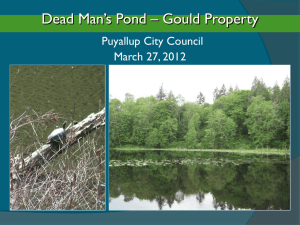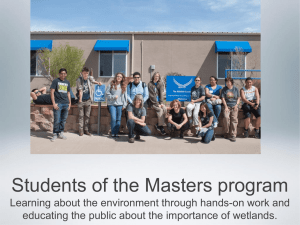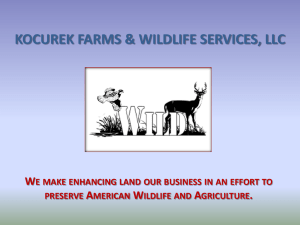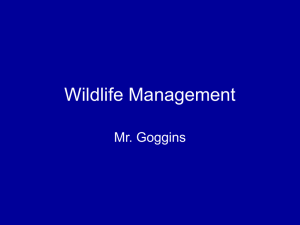Managing a Pond for Wildlife
advertisement
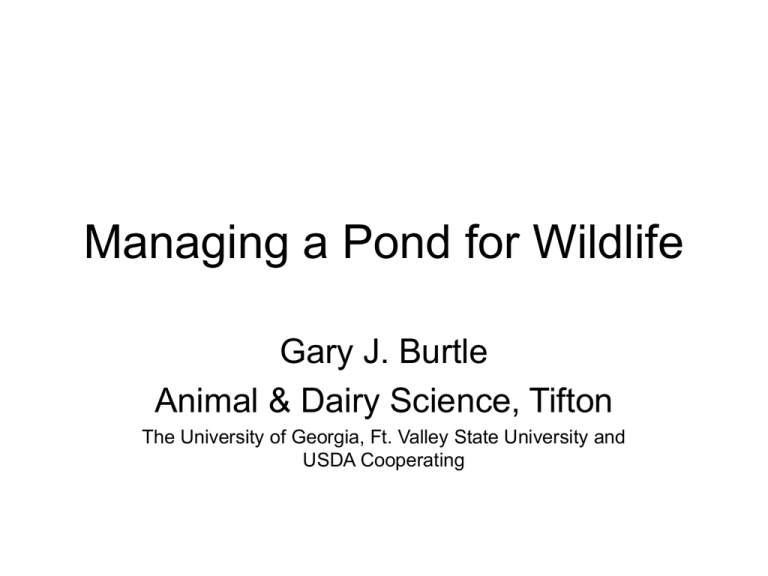
Managing a Pond for Wildlife Gary J. Burtle Animal & Dairy Science, Tifton The University of Georgia, Ft. Valley State University and USDA Cooperating Wildlife as a Goal • Share your pond with animals • Provide plants as habitat • Provide plants as food • Encourage the process of plant succession (eutrophication) Why attract wildlife? • Make an oasis or refuge for wildlife • Simple enjoyment of watching wildlife • Willingness to share the pond with wildlife Possible Disadvantages of Attracting Wildlife • Dangerous animals – Snakes, bears, alligators • Nuisance animals – Raccoons, deer, otters • Poacher trespass – Attracted to game that use the pond A dangerous visitor Types of Wildlife Ponds • Combination fishing/wildlife pond • Wildlife viewing pond • Wildlife refuge pond Wildlife and Fish • Need open water that is >4 ft deep • Access to pond edge • Fishing pier or boat access • Pond productivity may be low Wildlife and Fish • Plan to keep part of the pond open for access • Deep water will allow some fertilization for fish population management • Stock red ear sunfish to help reduce vectors of fish parasites • Small ponds do not need fish, dragonflies and frogs will control mosquitoes Wildlife Viewing Pond • Secluded areas • View of wildlife access points • Wildlife resting areas • Blinds or view from windows of home Wildlife Refuge Pond • Encourage pond to reach advanced plant succession • Shallow water encourages plant growth • Few human access points Backyard Wildlife Pond Encouraging Plant Succession • • • • Leave shallow areas in pond Lower pond in summer Plant the types of vegetation you want Watch for invasives and remove as soon as you see them Some Plant Possibilities Alternative plants • Submerged plants Ceratophyllum demersum Hornwort Eleocharis acicularis Hair Grass Mayaca fluviatilis Bog moss Potamogeton diversifolius Threadleaf pondweed Potamogeton pectinatus Sago pondweed Floating aquatic plants and Emergent plants Hydrocotyle ranunculoides Water penneywort Nymphaea odorata White Water Lily Nuphar advena Cow Lily Potamogeton illinoiensis Illinois pondweed Shrubs - Elderberry Trees - Pawpaw Marginal – Primrose willow Marginal – Swamp Loostrife Decorative – Marsh Hibiscus Marginal – Duck Potato Grasses – Bullrush Grasses – Fall Panic Grass Rushes and Sedges – Shore Rush Rushes to Stablize Pond Edge Marginal - Cattail Floating • Water lily • Spreads over shallow areas • Shade 50% of pond to limit algae growth • Remove by pruning to limit spread of lilies • Will populate areas of shallow water (less than 6 ft deep) Pickerel Weed Out of Control Submerged – Common Pondweeds (Potamogeton) Illinois Pondweed Submerged – Sago Pondweed Coontail Summary • • • • Choose your goal Encourage plant succession Choose plants carefully Enjoy wildlife Do you want wildlife at your doorstep?



